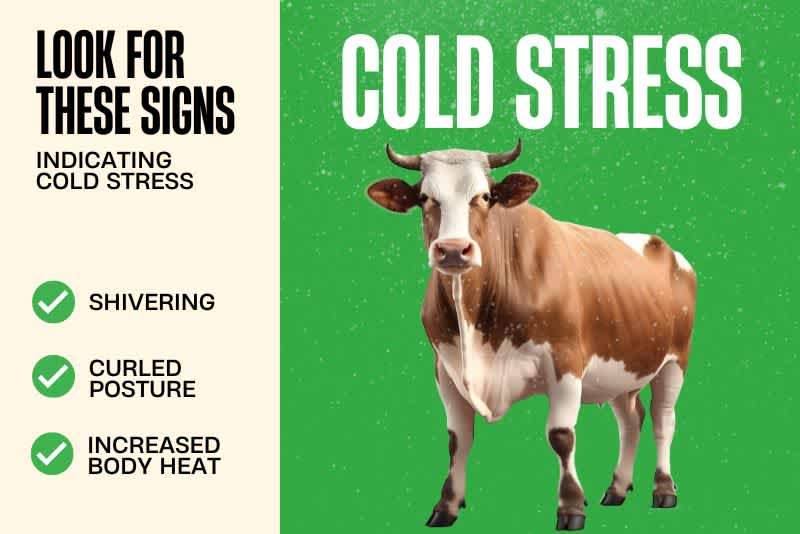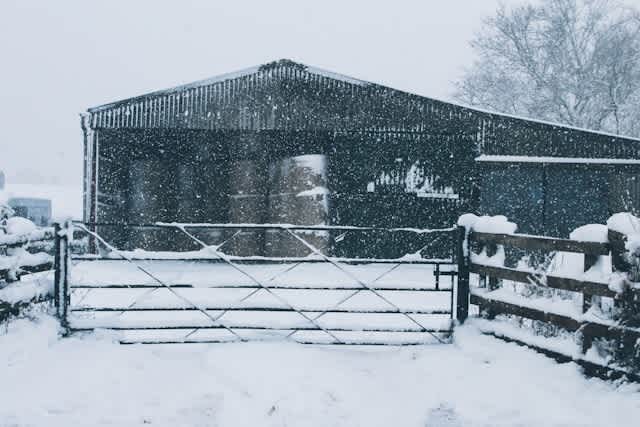Cold Cows: Everything YOU Need to Know About Their Winter Care
Published: February 22, 2024

Even in the harshest winters, cows are surprisingly hardy and capable with a little help from farmers.
Just like you winterize your home before the cold snap hits, cows, too, require special attention to ensure their well-being during winter. This isn't simply about animal ethics; winter care can significantly affect the cows’ milk yield, reproductive health, and overall productivity.
In this article, we'll uncover why a cow's winter resilience may rival that of a grizzled mountain explorer.
While you may have no problem surviving the winter chill yourself, your cold cows don't have the option of hot cocoa and thermal socks.
Key Takeaways:
Understand the concept of Cold Stress in cows, its impact on health, and its long-term effects on dairy and beef farm productivity.
Learn about the Lower Critical Temperature (LCT) for cows and how to identify signs of Cold Stress for timely intervention.
Effective steps for winterizing barns and providing adequate shelter to protect cows from harsh winter conditions.
Weigh the economic implications of investing in Cold Stress management and its long-term benefits to sustainable farming.
Understanding Cold Stress in Cows: The Key to Their Winter Survival
What is Cold Stress in Cows?
Cold stress in cows occurs when a drop in temperature pushes their bodies to spend more energy on maintaining body temperature than usual. This is particularly prevalent during winter or in cold climates, hence the term 'cold stress.'
A cow's metabolic rate rapidly increases as the temperature drops, triggering it to burn stored fats and proteins to keep warm. This amplified metabolic rate and energy expenditure will impact their health.
Low temperatures can threaten the cow's immune system, leaving it susceptible to diseases, infections, and lowered productivity. In particular, dairy cows may produce less milk, while beef cattle may see slowed weight gain. The effects of cold stress can be long-lasting, affecting the overall livestock performance and, therefore, the economic outcomes of your farm.
Lower Critical Temperature
LCT, or lower critical temperature, is a metric often used to understand a cattle's ability to fight off cold conditions. It usually varies depending on the thickness of the fur.
Cows considered in good condition on the body condition scale of 5 or better (heavy coat) can typically maintain a body weight until the wind chill index is 19°F or below.
Coat Type | Critical Temp |
|---|---|
Summer Coat | 58 degrees F |
Fall Coat | 45 degrees F |
Winter Coat | 32 degrees F |
Heavy Winter Coat | 19 degrees F |
Identifying Signs of Cold Stress in Cows
Recognizing the indicators of cold stress in your herd can considerably reduce its detrimental impact. Farmers, agriculturists, or anyone involved in livestock care should know these signs for timely intervention and care.
Physical signs include shivering, curled posture, and increased body heat as the cows try to keep warm. Changes in behavior are also apparent, with cows clustering together for warmth or frequently searching for food. In more severe cases, frostbite can occur, specifically at the extremities, like the ears, hooves, and tail.
Early detection allows timely interventions, effectively minimizing the impact on cows' health and productivity. Similarly, farmers can save on potentially substantial costs of treatments or loss of yield.

Remember that cows are resilient creatures. However, understanding and managing cold stress can make them more comfortable during winter, ensuring optimal productivity.
Steps to Protect Your Cows from Cold Stress
Step 1: Providing Adequate Shelter
Warehousing is the backbone of your cows' defense against frigid weather conditions. Your livestock are not resistant to extreme cold, so selecting the right barn can keep them warm even when the mercury dips below zero.
An appropriate shelter designed to guard against frostbite and hypothermia can be a lifesaver. Consider the following:
features for wind protection
the total load of the roofing for the snowfall
create entrances on appropriate sides of the barn
proper insulation and floor and room heating
Insulation is crucial in maintaining warmth when preparing the shelter, and hay or straw can be beneficial. Regular maintenance, such as fixing leaks and drafts, can prevent sudden temperature drops. Ensuring the shelter is clean, dry, and warm creates a conducive winter environment for your cows.
Step 2: Ensuring Proper Nutrition
Proper nutrition can be the deciding factor in how your cows handle cold stress. During winter, your cattle need more energy to maintain body temperature, hence the need for diet adjustments. Inadequate feed can lead to weight loss, lower milk production, and increased vulnerability to diseases due to weakened immunity.
Cows require a carbohydrate diet and energy-dense feeds like corn silage or alfalfa hay to conquer the cold stress. The amount of forage also depends on the weight and the quality of the feed you provide.
Step 3: Implementing Effective Herd Management Practices
Effective management is instrumental in minimizing the adverse impacts of cold stress on your herd. The emphasis should be on feeding, shelter, and regular health checks and monitoring. This helps to identify any unforeseen issues related to cold stress, such as frostbite or pneumonia, at an early stage.
While cows are quite resilient to the cold (say, compared to ourselves or dogs), on frigid days, limit their exposure by keeping them under shelter for most of the day. This can help avoid unnecessary cold stress and maintain good health throughout the winter.
Some common signs of cold stress include:
increased heart rate
huddling in a group to stay warm and to break the wind chill
deeper breathing
muscle shivering
Debunking Myths: Do Cows Get Cold in Cold Weather?
In keeping with nature's design, it is important to understand that cows come equipped with various physiological features that lend themselves to cold weather.
Their thick skin, coupled with a dense layer of fur, is an exceptional insulator, creating a barrier between their bodies and the wintry chill.
Cows also possess an innate capacity to adjust their metabolic rates in response to shifting temperatures. This perk of being ruminant becomes critical to them adjusting in winter, helping them generate extra heat from within.
Finally, farmers tend to provide extra feed during the winter, and this increased intake will also help them keep their temperatures elevated to get through the winter weather.
The Economic Impact of Cold Stress on Beef and Dairy Farms
How Cold Stress Affects Farm Productivity
Cold stress in cows can impact a farm's productivity. This is particularly evident when cows’ milk production and weight gain are compromised, directly impacting farm profitability.
Impact of Cold Stress on Cows' Milk Production and Weight Gain
When the mercury drops, cows channel most of their energy towards maintaining their core body temperature. This physiological adaptation leaves less energy for productive purposes, like milk synthesis and body mass accumulation, thereby reducing milk yield and weight gain.
Milk production, often a primary revenue stream for dairy farms, is compromised when cows experience cold stress. A dairy cow exposed to cold stress produces less milk daily than one in favorable environmental conditions.
Simultaneously, beef cattle growth rates slump as their energy converts into heat rather than muscle mass. This results in slower weight gain, stretching the time to reach market weight, delaying turnover, and reducing the farm’s profitability.
Cold Stress Impact on the Overall Productivity and Profitability of Farms
A drop in milk production and slower weight gain isn't only detrimental to the animal's health but affects the farm’s overall productivity and profitability. There are latent costs tied up with diminishing returns, longer feeding periods for beef cattle to reach market weight, and potential expenses arising from cold-stress-induced health complications.
Investing in Cold Stress Management: Is It Worth It?

Investing in cold stress management can initially seem challenging, but the pros significantly outweigh the cons when analyzed financially.
Cost-Benefit Analysis of Investing in Cold Stress Management
At face value, the cost of implementing a comprehensive cold stress management plan may seem steep. However, an effective protocol helps to maintain steady production levels even during the cold months, affecting the cost-benefit ratio positively.
The costs encompass warming infrastructure, nutritious feed supplements, and potentially higher veterinary care expenses. The benefits, on the other hand, are seen as consistent milk production, stable growth rates, fewer diseases, and overall healthier herds.
Long-Term Benefits of Proper Winter Care for Cows
Consideration of proper winter care reflects sustainable farm operations. Cows shielded from winter's harsh lash are healthy and productive and contribute towards steady profits.
A healthy, stress-free cow yields more milk, gains weight at a steady pace, and has a longer, more productive life. This constant flow of benefits underscores the imprudence of ignoring winter care in favor of short-term cost cuts.
Understanding the economic strains tied to ensuring proper cow care during cold months isn't about scaring farms into action, it's about making them cognizant of the importance of preventative measures and promoting robust, healthy and profitable operations. The mantra is clear: treat cold stress seriously, or it will affect your bottom line.
Conclusion
Knowing how to look after your herd in the chillier months is important for your farm. It's about more than just providing warmth; it involves monitoring health, maintaining proper nutrition, and offering protective shelter.
Remember, the comfort of your cattle is crucial, affecting their happiness and your bottom line. Make your cows' welfare a priority this winter; it could mean the difference between a good and great year.
Keep track of all your cattle with the #1 Cattle Management Software
Try out Ranchr today for free